Trees Birds Mammals Fish Amphibians Reptiles
Wild Algarve
Bookshop
Aseroë rubra (Labill.) Starfish Fungus
Phylum: Basidiomycota - Class: Agaricomycetes - Order: Phallales - Family: Phallaceae
Distribution - Taxonomic History - Etymology - Identification - Culinary Notes - Reference Sources
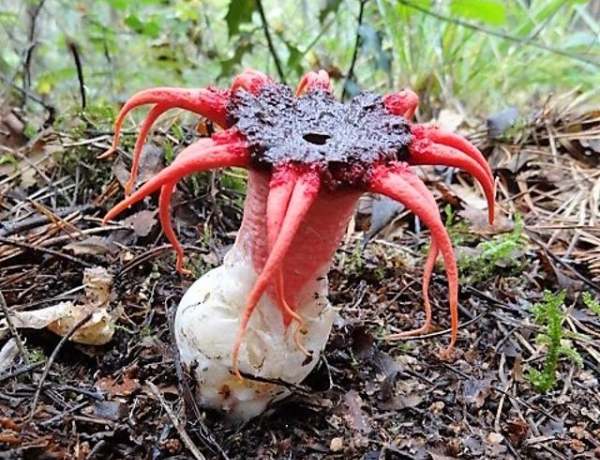
Aseroe rubra is arguably the most striking of all stinkhorn species found in Britain. It is, however, a non-native species, having been first imported to England from Australia (probably via the Netherlands in 1828, when it was first seen in Kew Gardens, in Surrey). The above picture, kindly contributed by Peter Taylor, was taken on Oxshott Common, in Surrey, and to date (2019) all other recorded sightings in Britain have been from locations in the county of Surrey.
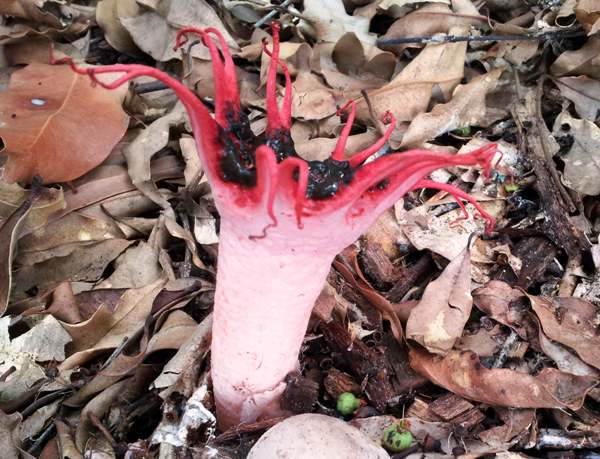
The Starfish Stinkhorn remains a very rare find in Britain.
Fruitbody development
The following sequence of three pictures, showing the developing fruitbody, was taken by Tony Raw in Oxshot Woods, Surrey:
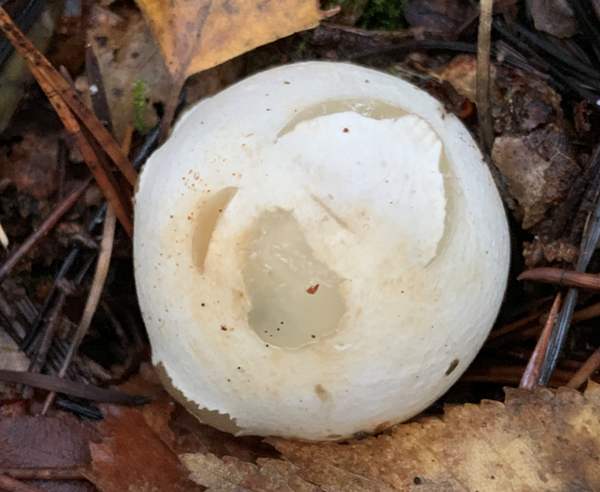
1. Egg stage
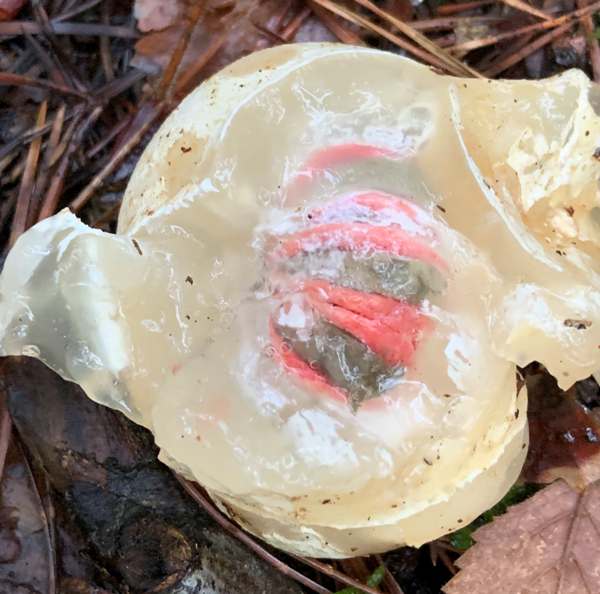
2. Fingers visible in developing fruitbody
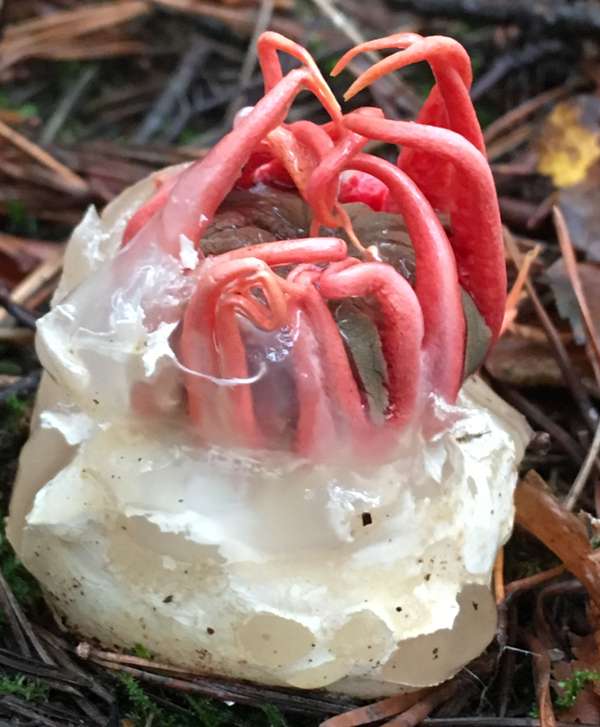
3. Fingers of Aseroe rubra emerging from the 'egg'
This species has also being imported to North America, where it was first recorded in California.
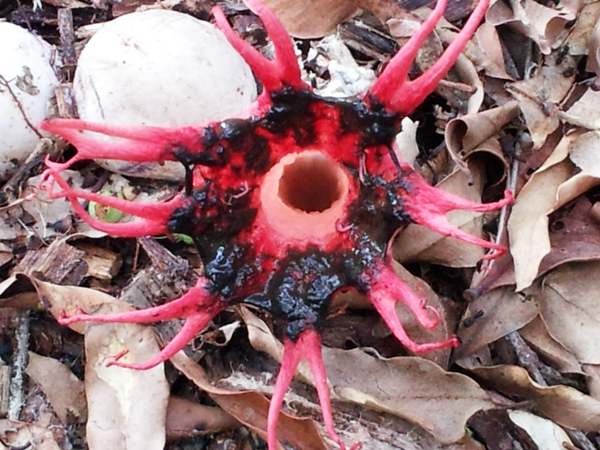
Distribution
Fairly common in parts of Australia, Aseroe rubra occurs also as a native species in Tasmania, New Zealand, South Africa and on several isolated islands in the Pacific.
The specimen shown above was seen growing (with several others) on the Sunshine Coast, Queensland, Australia, where it was photographed by Patrea Andersen. Several other red-toned stinkhorns are found in the same area. Elsewhere in the world red-coloured stinkhorns are found mainly in tropical and subtropical regions, although several Clathrus species are common in Mediterranean climes.
Taxonomic history
The Starfish Stinkhorn was first recorded by French biologist Jacques Labillardière (1755 - 1834), a member of the D'Entrecasteaux expedition, who collected a specimen in 1792 at Recherche Bay, Southern Tasmania, and published a scientific description of it in 1800, thereby establishing its currently-accepted scientific name Aseroë rubra.
Etymology
The generic name Aseroe refers to the spore-bearing sticky, smelly brownish gleba and comes from Greek Asē- and -roe, meaning 'disgusting juice'. The specific epithet rubra refers to the colour of the arms (tentacles!) of the fungal fruitbody; comes from Latin and means red. (Some people refer to this species as the Anemone Stinkhorn, because its red tentacles are reminiscent of certain kinds of Sea Anemones.)
Identification guide
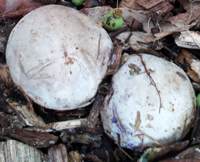 |
Egg stage
Before rupturing, the pale brown ball or egg of Aseroe rubra is typically 3cm in diameter and often visible above the surface of the leaf litter or rotting woody debris upon which it feeds.. |
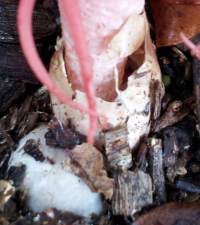 |
Volva
The pink-tinged stem of the Starfish Fungus emerges from its egg, leaving the torn remains of the outer peridium (the rubbery 'shell' of the egg) as a bag-like volva surrounding the base of the stem. |
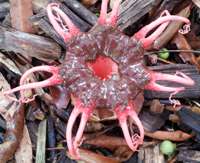 |
Mature stage
Usually eight, but sometimes as few as six or as many as ten or more initially conjoined but later bifurcated arms (each arm is split just once along two thirds of its length) emerge from the volva of the egg of this stinkhorn; the arms, each typically 3.5cm long, are attached to the top of a whitish stem 5-9cm tall and about 3cm in diameter. At maturity the stems tend to become hollow.
The upper surfaces of the sponge-like stem and the inner parts of the arms are coated with an olive-brown gleba that is laden with spores. |
| |
Spores
Elongated ellipsoidal, smooth, 4.5-7 x 1.5-2.5µm, inamyloid.
Spore print
Pale olive brown. |
Odour/taste |
Not anywhere near as strong-smelling as Clathrus archeri, but nevertheless giving off an unpleasant odour (strong enough to attract flies, but not so smelly that people are driven to move home to escape it!) reminiscent of rotting meat; it is likely that there is no distinctive
taste at the young egg stage, but I can find no reports about the taste of mature fruitbodies, which may even be poisonous! |
Habitat |
Aseroe rubra is saprobic and mainly found in leaf litter under trees and shrubs. |
Season |
Summer and early autumn in southern England. |
Similar species |
Clathrus archeri lacks a stem and its arms are not bifurcated. |
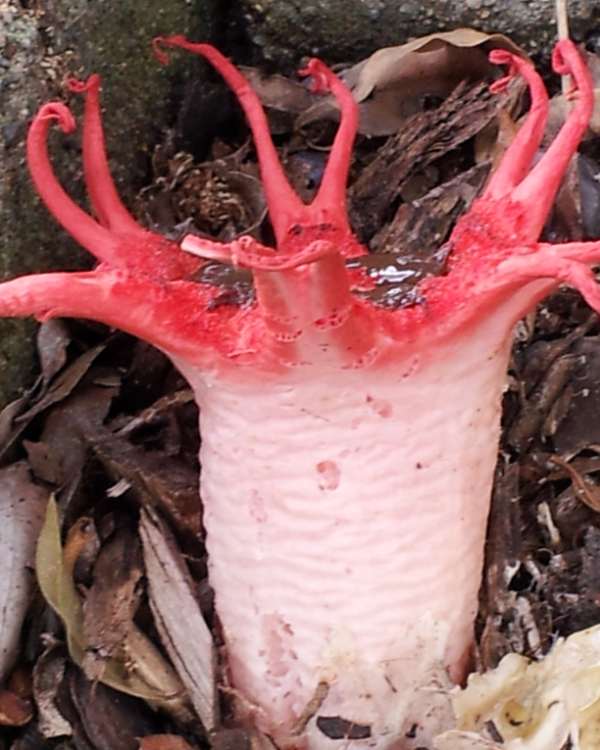
Culinary Notes
In common with most other kinds of stinkhorns, Aseroe rubra is best treated as suspect and not gathered for eating; indeed, in Britain this fungus is so rare that it really should not be collected.
Reference Sources
Pegler, D.N., Laessoe, T. & Spooner, B.M (1995). British Puffballs, Earthstars and Stinkhorns. Royal Botanic Gardens, Kew.
British Mycological Society, English Names for Fungi.
Dictionary of the Fungi; Paul M. Kirk, Paul F. Cannon, David W. Minter and J. A. Stalpers; CABI, 2008
Taxonomic history and synonym information on these pages is drawn from many sources but in particular from the British Mycological Society's GB Checklist of Fungi.
Acknowledgements
This page includes pictures kindly contributed by Tony Raw (Surrey, UK), by Peter Taylor (Surrey UK), and by Patrea Andersen (Queensland, Australia).
Top of page...
Fascinated by Fungi. Back by popular demand, Pat O'Reilly's best-selling 450-page hardback book is available now. The latest second edition was republished with a sparkling new cover design in September 2022 by Coch-y-Bonddu Books. Full details and copies are available from the publisher's online bookshop...